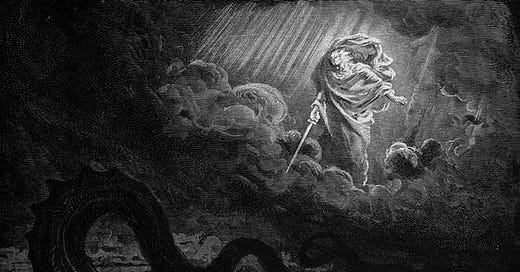Isaiah 27:1:
“In that day the Lord with His severe sword, great and strong,
Will punish Leviathan the fleeing serpent,
Leviathan that twisted serpent;
And He will slay the reptile that is in the sea.”
Here we read about two leviathans. Leviathan the fleeing serpent and leviathan the twisted serpent. For the sake of imagery, imagine Leviathan the fleeing serpent as a straight line, the ends always escaping one another, stretching out towards infinity. Imagine Leviathan the twisted serpent as a circle, a line twisted upon itself. With these two images in mind we can explore the Leviathan in this context as a symbol of fallen time. Anyone familiar with the work of Jonathan Pageau will already be familiar with the association of the leviathan and time, but for those who are unfamiliar with these ideas, we will introduce and explore this symbolism.
Time in Christianity is very unique in comparison to how time is categorized in other worldviews. Time as it is meant to exist as the waiting period between the love of two subjects; it is analogous to the eternal, instantaneous love between the Father and Son through the Holy Spirit.1 In a perfect world, time exists as the stringing together of events, all characterized by their existence as points of sacrificial love between subjects. Time as we experience it as fallen subjects, however, falls short of this perfect image. In a world without love, time simply collapses upon itself, unable to fulfill the very purpose of its existence (which is the stringing together acts of love). The progression of time reverts back upon itself and this is where we run into the experiences of time we see from fallen worldviews. Particularly relevant to the passage from Isaiah quoted above are the views of time in ancient Greek philosophy and in modernity.
Ancient Greek time can be characterized as circular. It is needless to say, the average ancient Greek citizen experienced time with a mythical narrative, albeit a perverted one, infused with spirits and gods (the malignance of these spirits and their narratives is not under question). The philosophers, however, had a largely different idea of the real passing of time. The philosophical categorization of time in antiquity can be characterized by the circularity of the heavenly bodies. An infinite continuum of meaningfully ambiguous moments bleeding into each other with no reference to any particular narratives or stories:
“ … the things that are closest to the beginning come before, what then prevents us from being closer to the beginning than those who lived at the time of the Trojan War? ... If the sequence of events forms a circle, since the circle has indeed neither beginning nor end, we cannot, by being closer to the beginning, come before them any more than they can be said to come before us.” Aristotle, Physics, IV
This is leviathan the twisted serpent, this is time collapsed upon itself, time without narrative. Time without beginning nor end, endlessly bound to the circularity of the heavenly bodies. This view of time, although distinct, is not entirely different from the experience of time in modernity. In modernity, we have rejected all the mystical feasts and fasts of the medieval calendar, and replaced them with the endless 9-5 climbing of the corporate ladder. In place of festal narrative we have the illusion of endless progress. This is leviathan the fleeing serpent. Time in modernity is defined by the productivity of a worker, ever striving higher and higher to the impossible goal of perfection. This is time without beginning or end, time defined by progress for the sake of progress, with no particular end goal in sight. This endless productivity is condemned in the bible as the failure to rest, the failure to respect the Sabbath. This is the sin of Adam and the sin of the Tower of Babel. The failure to rest is the failure to respect time as the joining together of events of love which are characterized by the cooperation of two or more subjects. In this progressive view of time, the reciprocation of the other—an essential moment within any act of love—becomes reduced to transactional communication for the sake of one's own progress. This is what we see in toxic corporate culture today — every relationship is built solely around how each actor can use the other for one's own personal financial gain.
So, both of these views of time, the circularity of ancient Greek time and the infinite progress of time in modernity are two sides of the same coin, which is the fallen experience of time symbolized in the Bible as the two leviathans. The solution to fallen time is breaking through these deadlocked systems by the sacrificial coming down of the Lord. The cross breaks through the enclosed circle of ancient Greek time by piercing out in all directions towards infinity. The cross breaks through the line of time in modernity by breaking through the dim greyscale horizontalism of corporate life with the vertical ascension towards the heavens. It is in receiving, mirroring and reciprocating the love of Christ on the cross that we too can escape the monotony of fallen time and experience the beauty of each moment as they lead us up towards eternity. This provides us with a much more accurate and beautiful image of time which is a spiral upwards and outwards, following the arms of the cross up and out towards the heavens.
We have numerous Substack posts and videos on the telosbound YouTube channel on the theology of time.




W Nate. Good to see you writing.
This is very insightful! I'm glad you mention Jonathan Pageau. His work is very important in understanding the depth of the Christian worldview.